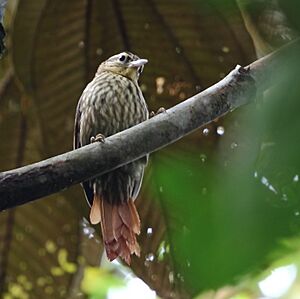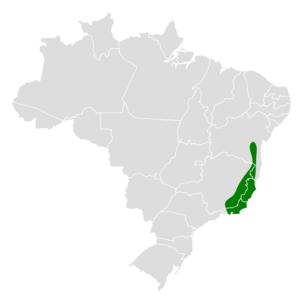Pale-browed treehunter facts for kids
Quick facts for kids Pale-browed treehunter |
|
|---|---|
 |
|
| At São Luiz do Paraitinga, São Paulo State, Brazil | |
| Conservation status | |
| Scientific classification | |
| Genus: |
Cichlocolaptes
|
| Species: |
leucophrus
|
 |
|
| Synonyms | |
|
|
The pale-browed treehunter (Cichlocolaptes leucophrus) is a cool bird that lives only in Brazil. It's part of the ovenbird family, called Furnariidae. These birds are known for building unique nests that sometimes look like ovens!
Contents
About the Pale-browed Treehunter
How Scientists Classify This Bird
Sometimes, scientists don't fully agree on how to classify animals. For the pale-browed treehunter, most groups like the American Ornithological Society agree it's one species with two types. These types are called subspecies. They are named C. l. leucophrus and C. l. holti.
However, another group, BirdLife International, thinks these two types are actually separate species. They call them the "large" and "small" pale-browed treehunters. For this article, we'll follow the idea that it's one species with two subspecies.
The pale-browed treehunter belongs to the Cichlocolaptes genus. Another bird in this group, the cryptic treehunter, is sadly believed to be extinct.
What Does This Bird Look Like?
The pale-browed treehunter is a medium-sized bird. The C. l. leucophrus subspecies is about 22 centimeters (8.7 inches) long. The C. l. holti subspecies is a bit smaller, around 18 centimeters (7.1 inches) long. Both male and female birds look alike.
They have a long, pointed beak, like a dagger. Above their eyes, they have a light, buff-white stripe called a supercilium. Their face is a dull buff color, with a dark brown band behind each eye. The top of their head is dark brown with lighter streaks.
Their back is reddish-brown with blurry light streaks. Their tail is a pale reddish-orange. Their wings are brown. Their throat is a light yellowish-buff. Their chest has strong light and brown streaks, which fade as you go down to their belly. Their eyes are very dark. Their legs and feet can be greenish-gray or light brownish.
Young birds look a lot like adults. However, the streaks on their underside are not as clear. The C. l. holti subspecies is smaller. It has a wider, paler stripe above its eye and a darker reddish tail.
Where Does the Treehunter Live?
The pale-browed treehunter lives in southeastern Brazil. The C. l. leucophrus subspecies is found from southern Bahia state down to Rio de Janeiro state. The C. l. holti subspecies lives further south, from São Paulo state to northeastern Rio Grande do Sul.
These birds prefer to live in humid, lowland, and mountain evergreen forests. The C. l. leucophrus subspecies can be found from sea level up to about 1,500 meters (4,900 feet) high. The C. l. holti subspecies usually stays below 1,000 meters (3,300 feet).
Treehunter Behavior
Movement and Daily Life
The pale-browed treehunter stays in the same area all year round. It doesn't migrate to other places.
What Do Treehunters Eat?
These birds mostly eat arthropods, which are creatures like insects and spiders. They often join groups of different bird species that feed together. This is called a mixed-species feeding flock. They search for food at all levels of the forest, from the lower plants to the tops of the trees.
They like to look for food along large branches. They poke and pick at the bark and leaves. They especially love to search for prey in bromeliads and other epiphytes. These are plants that grow on other plants, like trees. Sometimes, a treehunter will even go completely inside a clump of bromeliads. It might even hang upside-down to get its meal!
Reproduction and Life Cycle
Right now, scientists don't know much about how the pale-browed treehunter breeds or raises its young. More research is needed to understand their family life.
How Treehunters Communicate
The songs of the two subspecies sound a little different in pitch. Generally, their songs are "loud, ringing 'reep' notes." They can have a different number of these notes. Sometimes, they mix in fast chattering sounds. Their call is a loud "krip, shrip."
Conservation Status
The IUCN (International Union for Conservation of Nature) assesses the conservation status of animals. They follow the idea that the "large" and "small" pale-browed treehunters are separate species. Both are listed as "Least Concern." This means they are not currently in danger of extinction.
Even though their populations are believed to be decreasing, they still have large areas where they live. No immediate threats have been found for them. Both subspecies are considered rare in some places but common in others. They can be found in several protected areas. However, a lot of their habitat, the Atlantic Forest, has been cleared. This leaves less suitable space for them to live.


